

RDF Query Survey. This document provides a survey of RDF query language and implementations and describes their capabilities in terms described in RDF Query and Rules Framework.
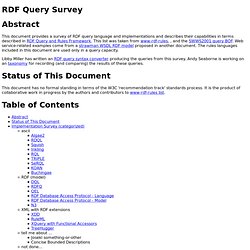
This list was taken from www-rdf-rules, , and the SWWS2001 query BOF. Web service-related examples come from a strawman WSDL RDF model proposed in another document. The rules languages included in this document are used only in a query capacity. Libby Miller has written an RDF query syntax converter producing the queries from this survey. Andy Seaborne is working on an taxonomy for recording (and comparing) the results of these queries. This document has no formal standing in terms of the W3C 'recommendation track' standards process. The languages express the query in customized grammars. @@ These tend to be the tersest representations Algae2 Algae is a table-oriented query (and rules) language. ns rdf=< ns wsdl=< ns wssoap=< slurp () ask (? RDF/XML Syntax Specification (Revised) Abstract The Resource Description Framework (RDF) is a general-purpose language for representing information in the Web.
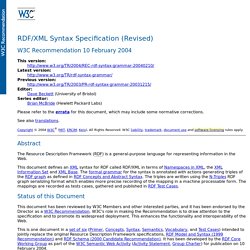
This document defines an XML syntax for RDF called RDF/XML in terms of Namespaces in XML, the XML Information Set and XML Base. The formal grammar for the syntax is annotated with actions generating triples of the RDF graph as defined in RDF Concepts and Abstract Syntax. The triples are written using the N-Triples RDF graph serializing format which enables more precise recording of the mapping in a machine processable form. The mappings are recorded as tests cases, gathered and published in RDF Test Cases. 1 Introduction. RDF Schema. The first version[1][2] was published by the World-Wide Web Consortium (W3C) in April 1998, and the final[3] W3C recommendation was released in February 2004.
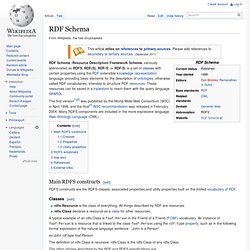
Many RDFS components are included in the more expressive language Web Ontology Language (OWL). Main RDFS constructs[edit] RDFS constructs are the RDFS classes, associated properties and utility properties built on the limited vocabulary of RDF. Classes[edit] ex:John rdf:type foaf:Person The definition of rdfs:Class is recursive: rdfs:Class is the rdfs:Class of any rdfs:Class. Resource Description Framework. The Resource Description Framework (RDF) is a family of World Wide Web Consortium (W3C) specifications[1] originally designed as a metadata data model.
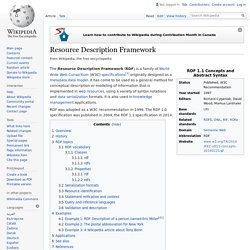
It has come to be used as a general method for conceptual description or modeling of information that is implemented in web resources, using a variety of syntax notations and data serialization formats. It is also used in knowledge management applications. RDF was adopted as a W3C recommendation in 1999. The RDF 1.0 specification was published in 2004, the RDF 1.1 specification in 2014. Overview[edit] RDF is an abstract model with several serialization formats (i.e. file formats), so the particular encoding for resources or triples varies from format to format. As RDFS and OWL demonstrate, one can build additional ontology languages upon RDF. RDF query language. An RDF query language is a computer language, specifically a query language for databases, able to retrieve and manipulate data stored in Resource Description Framework format.
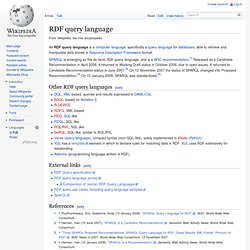
SPARQL is emerging as the de facto RDF query language, and is a W3C recommendation.[1] Released as a Candidate Recommendation in April 2006, it returned to Working Draft status in October 2006, due to open issues. It returned to Candidate Recommendation status in June 2007.[2] On 12 November 2007 the status of SPARQL changed into Proposed Recommendation.[3] On 15 January 2008, SPARQL was standardized.[4] SPARQL. SPARQL (pronounced "sparkle", a recursive acronym for SPARQL Protocol and RDF Query Language) is an RDF query language, that is, a semantic query language for databases, able to retrieve and manipulate data stored in Resource Description Framework format.[2][3] It was made a standard by the RDF Data Access Working Group (DAWG) of the World Wide Web Consortium, and is recognized as one of the key technologies of the semantic web.

On 15 January 2008, SPARQL 1.0 became an official W3C Recommendation,[4][5] and SPARQL 1.1 in March, 2013.[6] SPARQL allows for a query to consist of triple patterns, conjunctions, disjunctions, and optional patterns.[7] Implementations for multiple programming languages exist.[8] "SPARQL will make a huge difference" making the web machine-readable according to Sir Tim Berners-Lee in a May 2006 interview.[9] Advantages[edit] The example below demonstrates a simple query that leverages the ontology definition "foaf", often called the "friend-of-a-friend" ontology.